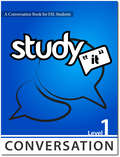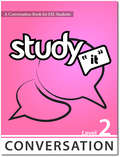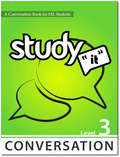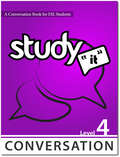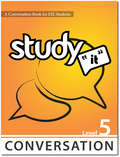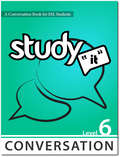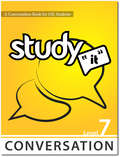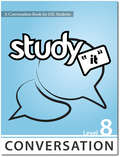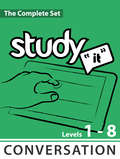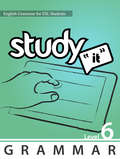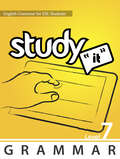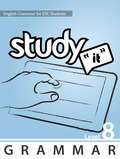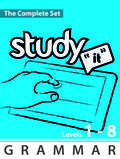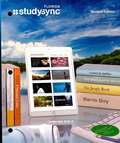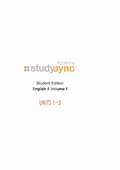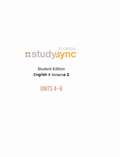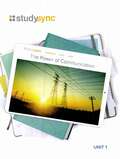- Table View
- List View
Study It Conversation Level 1: A Conversation Book for ESL Students (Study It)
by James Rice Jamie MatechukWinner 2015 Digital Book Award - Academic Category Awarded QED Certification for Quality, Excellence and Design The Study It Conversation series is an easy-to-use speaking-based ESL textbook for ESL students, language teachers and English language programs in schools or language schools. The Study It English ESL Conversation series consists of 8 different levels and 8 different English conversation books. The Study It Conversation series consists of the following: 20 different conversation topics, vocabulary-building exercises, video and audio exercises, clear language points for each conversation topic, Communicative and Project-based learning activities. Book 1 is designed for Beginner students. Some of the conversation topics in Book 1 include: Ordering at a Restaurant, Meeting People, Time Talk, Hotel Reservations and much more. ESL Teachers can access our online community which offers teachers a chance to share ideas for improving the English class. Teachers interested in Mobile Learning, Project-Based Learning or Flipping the Classroom will enjoy the Study It series.
Study It Conversation Level 2: A Conversation Book for ESL Students (Study It)
by James Rice Jamie MatechukWinner 2015 Digital Book Award - Academic Category Awarded QED Certification for Quality, Excellence and Design The Study It Conversation series is an easy-to-use speaking-based ESL textbook for ESL students, language teachers and English language programs in schools or language schools. The Study It English ESL Conversation series consists of 8 different levels and 8 different English conversation books. The Study It Conversation series consists of the following: 20 different conversation topics, vocabulary-building exercises, video and audio exercises, clear language points for each conversation topic, Communicative and Project-based learning activities. Book 2 is designed for Beginner and Pre-Intermediate level students. Some of the conversation topics in Book 2 include: Pet Peeves, Narrating a Story, Renting a Car, Buying and Selling and much more. ESL Teachers can access our online community which offers teachers a chance to share ideas for improving the English class. Teachers interested in Mobile Learning, Project-Based Learning or Flipping the Classroom will enjoy the Study It series.
Study It Conversation Level 3: A Conversation Book for ESL Students (Study It)
by James Rice Jamie MatechukWinner 2015 Digital Book Award - Academic Category Awarded QED Certification for Quality, Excellence and Design The Study It Conversation series is an easy-to-use speaking-based ESL textbook for ESL students, language teachers and English language programs in schools or language schools. The Study It English ESL Conversation series consists of 8 different levels and 8 different English conversation books. The Study It Conversation series consists of the following: 20 different conversation topics, vocabulary-building exercises, video and audio exercises, clear language points for each conversation topic, Communicative and Project-based learning activities. Book 3 is designed for Pre-Intermediate and Intermediate students of ESL. Some of the conversation topics in Book 3 include: Like vs Dislike, Introduction to Idioms, Amazing Experiences, and On thePphone etc. ESL Teachers can access our online community which offers teachers a chance to share ideas for improving the English class. Teachers interested in Mobile Learning, Project-Based Learning or Flipping the Classroom will enjoy the Study It series.
Study It Conversation Level 4: A Conversation Book for ESL Students (Study It)
by James Rice Jamie MatechukWinner 2015 Digital Book Award - Academic Category Awarded QED Certification for Quality, Excellence and Design The Study It Conversation series is an easy-to-use speaking-based ESL textbook for ESL students, language teachers and English language programs in schools or language schools. The Study It English ESL Conversation series consists of 8 different levels and 8 different English conversation books. The Study It Conversation series consists of the following: 20 different conversation topics, vocabulary-building exercises, video and audio exercises, clear language points for each conversation topic, Communicative and Project-based learning activities. Book 4 is designed for Intermediate students of ESL. Some of the conversation topics in Book 4 include: Giving Advice, Complaining and Apologizing, Podcasts, Idioms, Narrating a Story, Unsolved Mysteries, Emergencies, and many more. ESL Teachers can access our online community which offers teachers a chance to share ideas for improving the English class. Teachers interested in Mobile Learning, Project-Based Learning or Flipping the Classroom will enjoy the Study It series.
Study It Conversation Level 5: A Conversation Book for ESL Students (Study It )
by James Rice Jamie MatechukWinner 2015 Digital Book Award - Academic Category Awarded QED Certification for Quality, Excellence and Design The Study It Conversation series is an easy-to-use speaking-based ESL textbook for ESL students, language teachers and English language programs in schools or language schools. The Study It English ESL Conversation series consists of 8 different levels and 8 different English conversation books. The Study It Conversation series consists of the following: 20 different conversation topics, vocabulary-building exercises, video and audio exercises, clear language points for each conversation topic, Communicative and Project-based learning activities. Book 5 is designed for Intermediate and Upper-Intermediate students of ESL. Some of the conversation topics in Book 5 include: Giving a Presentation, Travel and Tourism, Marriage, Creating a Commercial etc. ESL Teachers can access our online community which offers teachers a chance to share ideas for improving the English class. Teachers interested in Mobile Learning, Project-Based Learning or Flipping the Classroom will enjoy the Study It series.
Study It Conversation Level 6: A Conversation Book for ESL Students (Study It )
by James Rice Jamie MatechukWinner 2015 Digital Book Award - Academic Category Awarded QED Certification for Quality, Excellence and Design The Study It Conversation series is an easy-to-use speaking-based ESL textbook for ESL students, language teachers and English language programs in schools or language schools. The Study It English ESL Conversation series consists of 8 different levels and 8 different English conversation books. The Study It Conversation series consists of the following: 20 different conversation topics, vocabulary-building exercises, video and audio exercises, clear language points for each conversation topic, Communicative and Project-based learning activities. Book 6 is designed for upper-Intermediate students of ESL. Some of the conversation topics in Book 6 include: Arguing and Compromise, At Work, Online Dating and much more ESL Teachers can access our online community which offers teachers a chance to share ideas for improving the English class. Teachers interested in Mobile Learning, Project-Based Learning or Flipping the Classroom will enjoy the Study It series.
Study It Conversation Level 7: A Conversation Book for ESL Students (Study It)
by James Rice Jamie MatechukWinner 2015 Digital Book Award - Academic Category Awarded QED Certification for Quality, Excellence and Design The Study It Conversation series is an easy-to-use speaking-based ESL textbook for ESL students, language teachers and English language programs in schools or language schools. The Study It English ESL Conversation series consists of 8 different levels and 8 different English conversation books. The Study It Conversation series consists of the following: 20 different conversation topics, vocabulary-building exercises, video and audio exercises, clear language points for each conversation topic, Communicative and Project-based learning activities. Book 7 is designed for Upper-Intermediate and Advanced students of ESL. Some of the conversation topics in Book 7 include: Fears and Phobias, Cold Feet, Driving, Advanced Idioms, Global Warming and much more ESL Teachers can access our online community which offers teachers a chance to share ideas for improving the English class. Teachers interested in Mobile Learning, Project-Based Learning or Flipping the Classroom will enjoy the Study It series.
Study It Conversation Level 8: A Conversation Book for ESL Students (Study It )
by James Rice Jamie MatechukWinner 2015 Digital Book Award - Academic Category Awarded QED Certification for Quality, Excellence and Design The Study It Conversation series is an easy-to-use speaking-based ESL textbook for ESL students, language teachers and English language programs in schools or language schools. The Study It English ESL Conversation series consists of 8 different levels and 8 different English conversation books. The Study It Conversation series consists of the following: 20 different conversation topics, vocabulary-building exercises, video and audio exercises, clear language points for each conversation topic, Communicative and Project-based learning activities. Book 8 is designed for Advanced students of ESL. Some of the conversation topics in Book 8 include: Plan a Town, Meeting Up, Business Meetings, Cross Cultural Confusion and much more ESL Teachers can access our online community which offers teachers a chance to share ideas for improving the English class. Teachers interested in Mobile Learning, Project-Based Learning or Flipping the Classroom will enjoy the Study It series.
Study It Conversation Levels 1-8: The Complete Set (Study It)
by James Rice Jamie MatechukWinner 2015 Digital Book Award - Academic Category Awarded QED Certification for Quality, Excellence and Design The Study It Conversation series is an easy-to-use conversation-based English textbook for ESL students, language teachers and English language programs in schools or language schools. The Study It English as a Second Language Conversation series consists of 8 different levels and 8 different textbooks. It is an exciting new series for teachers interested in Mobile Learning, Project-Based Learning or Flipping the Classroom that includes built-in lesson plans. Study It Conversation - The Complete Set consists of all conversation textbooks combined into one easy-to-use book All audio and video exercises are included in the book. ESL Teachers can access our online community which offers teachers a chance to share ideas for improving the English class
Study It Grammar Level 6: English Grammar for ESL Students (Study It )
by James Rice Jamie MatechukWinner 2015 Digital Book Award - Academic Category Awarded QED Certification for Quality, Excellence and Design The Study It Grammar series is aneasy-to-use integrated skills ESL textbook for ESL students, language teachers and English language programs in schools or language schools. It is an exciting new series for teachers interested in Mobile Learning, Project-Based Learning or Flipping the Classroom. The Study It English Grammar series consists of 8 different levels. Book 6 of 8 is for Intermediate English as a Second Language learners. The Study It Grammar Book 6 consists of the following: - Video exercises - 5 different themes including noun phrases, participle adjectives, gerunds and infinitives and much more. - Each unit contains vocabulary, listening, speaking, writing and reading practice. ESL Teachers can access our online community which offesr teachers a chance to share ideas for improving the English class
Study It Grammar Level 7: English Grammar for ESL Students (Study It)
by James Rice Dianne LaneWinner 2015 Digital Book Award - Academic Category Awarded QED Certification for Quality, Excellence and Design The Study It Grammar series is an easy-to-use integrated skills ESL textbook for ESL students, language teachers and English language programs in schools or language schools. It is an exciting new series for teachers interested in Mobile Learning, Project-Based Learning or Flipping the Classroom. The Study It English Grammar series consists of 8 different levels. Book 7 of 8 is for Advanced English as a Second Language learners. The Study It Grammar Book 7 consists of the following: - Video exercises - 5 different themes including reported speech, relative clauses, noun clauses and much more. - Grammar, Reading, Writing and Speaking practice exercises included ESL Teachers can access our online community which offers teachers a chance to share ideas for improving the English class.
Study It Grammar Level 8: English Grammar for ESL Students (Study It)
by James Rice Dianne LaneWinner 2015 Digital Book Award - Academic Category Awarded QED Certification for Quality, Excellence and Design The Study It Grammar series is an easy-to-use integrated skills ESL textbook for ESL students, language teachers and English language programs in schools or language schools. The Study It English Grammar series consists of 8 different levels. Book 8 of 8 is for Advanced English as a Second Language learners. It is an exciting new series for teachers interested in Mobile Learning, Project-Based Learning or Flipping the Classroom The Study It Grammar Book 8 consists of the following: - Video exercises - 5 different themes including: conditionals, different verbal formation including time and tense verbals, and much more. - Grammar, Reading, Writing and Speaking practice exercises included ESL Teachers can access our online community which offers teachers a chance to share ideas for improving the English class
Study It Grammar Levels 1-8: The Complete Set (Study It)
by James Rice Jamie Matechuk Diana Rechichi-Gjorvska Dianne LaneWinner 2015 Digital Book Award - Academic Category Awarded QED Certification for Quality, Excellence and Design The Study It Grammar series is an easy-to-use integrated skills English textbook for ESL students, language teachers and English language programs in schools or language schools. The Study It English as a Second Language Grammar series consists of 8 different levels and 8 different textbooks. It is an exciting new series for teachers interested in Mobile Learning, Project-Based Learning or Flipping the Classroom that includes built-in lesson plans. Study It Grammar - The Complete Set consists of all grammar textbooks combined into one easy-to-use book All audio and video exercises are included in the book. ESL Teachers can access our online community which offers teachers a chance to share ideas for improving the English class
Study of Rural-Urban Sociology 3rd BA Course-3 Block 1-4
by Karnataka State Open UniversityThe document is a 3rd-year B.A. sociology textbook on Rural-Urban Sociology, covering rural and urban societies, their development, issues, and interactions. It is published by Karnataka State Open University and serves as study material for academic and competitive exams.
StudySync Core ELA Grade 7: Florida Reading and Writing Companion, Units 1-6
by StudySyncStudySync Core ELA Grade 7, Florida Reading and Writing Companion, Units 1-6
StudySync Core ELA: Reading and Writing Companion, Volume 1
by BookheadEd LearningStudySync Core ELA Grade 12 Florida Reading and Writing Companion Volume 1 Florida Edition
StudySync Core ELA: Reading and Writing Companion, Volume 2
by BookheadEd LearningEnglish language arts textbook for Grade 12 students.
StudySync Core ELA: Student Reading and Writing Companion Grade 10
by BookheadED LearningStudySync Core ELA Grade 10 Student Reading and Writing Companion
StudySync Reading and Writing Companion Grade 6
by StudySyncStudySync Reading and Writing Companion
StudySync [Grade 6], Reading & Writing Companion [Unit 1]: Turning Points
by BookheadEd LearningNIMAC-sourced textbook
StudySync [Grade 6], Reading & Writing Companion [Unit 2]: Ancient Realms
by BookheadEd LearningNIMAC-sourced textbook
StudySync [Grade 6], Reading & Writing Companion [Unit 2]: Ancient Realms
by McGraw-Hill EducationNIMAC-sourced textbook
StudySync [Grade 6], Reading & Writing Companion [Unit 3]: Facing Challenges
by BookheadEd LearningNIMAC-sourced textbook
StudySync [Grade 6], Reading & Writing Companion [Unit 3]: Facing Challenges
by BookheadEd Learning LlcNIMAC-sourced textbook
StudySync [Grade 6], Reading & Writing Companion [Unit 4]: Our Heroes
by BookheadEd LearningNIMAC-sourced textbook
